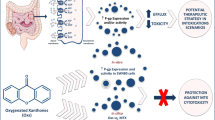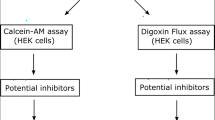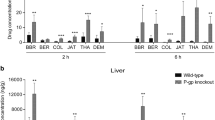Abstract
Our research group has been focusing in the discovery of potential antitumor small molecules based on the xanthone scaffold. However, a serious obstacle in the field of cancer therapy is the multidrug resistance (MDR) phenotype, most often caused by the overexpression of P-glycoprotein (P-gp). Another limitation to development of such drug candidates is the reduced information available about the bioavailability of these compounds. We have previously identified four interesting compounds as inhibitors of tumor cell growth namely two dihydroxyxanthones, a xanthonolignoid and a pyranoxanthone. Based on these considerations, it was our aim to: (i) investigate their effect on the P-gp activity; and (ii) estimate their intestinal absorption using Caco-2 cell monolayers as an intestinal model. An HPLC analysis from the in vitro permeation assay with Caco-2 cells monolayer was performed to predict the intestinal permeability of xanthonic derivatives. A rhodamine (Rh123) accumulation assay using P-gp overexpressing leukemia cells, K562Dox, incubated with the four xanthonic derivatives, was performed to investigate their P-gp inhibitory activity. A luminescence-based ATPase assay was performed to differentiate between competitive and noncompetitive P-gp inhibitors. The xanthonolignoid and the pyranoxanthone were found to increase the accumulation of Rh123 in K562Dox cell line, and both were acting by a noncompetitive P-gp inhibitory mechanism. Transport of the four xanthones occurred in the absorptive direction (Papp, 0.012–2.8 nm/s). The behavior of the xanthonolignoid and the pyranoxanthone as P-gp inhibitors and their high apparent permeability coefficients make them promising hit compounds to pursue with further studies.





Similar content being viewed by others
References
Balimane PV, Han YH, Chong S (2006) Current industrial practices of assessing permeability and P-glycoprotein interaction. AAPS J 8(1):E1–E13. doi:10.1208/aapsj080101
Boumendjel A, Di Pietro A, Dumontet C, Barron D (2002) Recent advances in the discovery of flavonoids and analogs with high-affinity binding to P-glycoprotein responsible for cancer cell multidrug resistance. Med Res Rev 22(5):512–529. doi:10.1002/med.10015
Camenisch G, Alsenz J, van de Waterbeemd H, Folkers G (1998) Estimation of permeability by passive diffusion through Caco-2 cell monolayers using the drugs’ lipophilicity and molecular weight. Eur J Pharm Sci 6(4):317–324. doi:S0928098797100197 [pii]
Eddershaw PJ, Beresford AP, Bayliss MK (2000) ADME/PK as part of a rational approach to drug discovery. Drug Discov Today 5(9):409–414. doi:S1359-6446(00)01540-3 [pii]
Ford JM (1996) Experimental reversal of P-glycoprotein-mediated multidrug resistance by pharmacological chemosensitisers. Eur J Cancer 32A(6):991–1001
Goda K, Bacso Z, Szabo G (2009) Multidrug resistance through the spectacle of P-glycoprotein. Curr Cancer Drug Targets 9(3):281–297
Gottesman MM, Fojo T, Bates SE (2002) Multidrug resistance in cancer: role of ATP-dependent transporters. Nat Rev Cancer 2(1):48–58. doi:10.1038/nrc706
He Y, Zeng S (2005) Transport characteristics of rutin deca (H-) sulfonate sodium across Caco-2 cell monolayers. J Pharm Pharmacol 57(10):1297–1303. doi:10.1211/jpp.57.10.0008
Hennessy M, Spiers JP (2007) A primer on the mechanics of P-glycoprotein the multidrug transporter. Pharmacol Res 55(1):1–15. doi:10.1016/j.phrs.2006.10.007 S1043-6618(06)00189-7 [pii]
ICH harmonised tripartite guideline (2005) Validation of analytical procedures: text and methodology Q2(R1). International Conference on Harmonization. http://www.ich.org/fileadmin/Public_Web_Site/ICH_Products/Guidelines/Quality/Q2_R1/Step4/Q2_R1__Guideline.pdf. Accessed 27 August 2012
Johnson D (1999) The discovery-development interface has become the new interfacial phenomenon. Drug Discov Today 4(12):535–536. doi:S1359-6446(99)01423-3 [pii]
Juliano RL, Ling V (1976) A surface glycoprotein modulating drug permeability in Chinese hamster ovary cell mutants. Biochim Biophys Acta 455(1):152–162. doi:0005-2736(76)90160-7 [pii]
Kostakis IK, Tenta R, Pouli N, Marakos P, Skaltsounis A-L, Pratsinis H, Kletsas D (2005) Design, synthesis, and antiproliferative activity of some novel aminosubstituted xanthenones, able to overcome multidrug resistance toward MES-SA/Dx5 cells. Bioorg Med Chem Lett 15(22):5057–5060
Levy E, Mehran M, Seidman E (1995) Caco-2 cells as a model for intestinal lipoprotein synthesis and secretion. FASEB J 9(8):626–635
Litman T, Zeuthen T, Skovsgaard T, Stein WD (1997) Competitive, non-competitive and cooperative interactions between substrates of P-glycoprotein as measured by its ATPase activity. Biochim Biophys Acta 1361(2):169–176. doi:S0925-4439(97)00027-6 [pii]
Loo TW, Clarke DM (2000) Identification of residues within the drug-binding domain of the human multidrug resistance P-glycoprotein by cysteine-scanning mutagenesis and reaction with dibromobimane. J Biol Chem 275(50):39272–39278. doi:10.1074/jbc.M007741200 M007741200 [pii]
Maitrejean M, Comte G, Barron D, El Kirat K, Conseil G, Di Pietro A (2000) The flavanolignan silybin and its hemisynthetic derivatives, a novel series of potential modulators of P-glycoprotein. Bioorg Med Chem Lett 10(2):157–160. doi:S0960-894X(99)00636-8 [pii]
Manach C, Williamson G, Morand C, Scalbert A, Remesy C (2005) Bioavailability and bioefficacy of polyphenols in humans. I. Review of 97 bioavailability studies. Am J Clin Nutr 81(1 Suppl):230S–242S. doi:81/1/230S [pii]
Paiva A, Sousa M, Camões A, Nascimento M, Pinto M (2011) Prenylated xanthones: antiproliferative effects and enhancement of the growth inhibitory action of 4-hydroxytamoxifen in estrogen receptor-positive breast cancer cell line. Med Chem Res 1-7. doi:10.1007/s00044-011-9562-z
Palmeira A, Paiva A, Sousa E, Seca H, Almeida GM, Lima RT, Fernandes MX, Pinto M, Vasconcelos MH (2010) Insights into the in vitro antitumor mechanism of action of a new pyranoxanthone. Chem Biol Drug Des 76(1):43–58
Palmeira A, Rodrigues F, Sousa E, Pinto M, Vasconcelos MH, Fernandes MX (2011) New uses for old drugs: pharmacophore-based screening for the discovery of P-glycoprotein inhibitors. Chem Biol Drug Des 78(1):57–72. doi:10.1111/j.1747-0285.2011.01089.x
Palmeira A, Vasconcelos MH, Paiva A, Fernandes MX, Pinto M, Sousa E (2012) Design of dual inhibitors of P-glycoprotein and tumor cell growth: (re)discovering thioxanthones. Biochem Pharmacol 83:57–68. doi:10.1016/j.bcp.2011.10.004
Pedro M, Cerqueira F, Sousa ME, Nascimento MS, Pinto M (2002) Xanthones as inhibitors of growth of human cancer cell lines and their effects on the proliferation of human lymphocytes in vitro. Bioorg Med Chem 10(12):3725–3730. doi:S0968089602003796 [pii]
Pinto MM, Sousa ME, Nascimento MS (2005) Xanthone derivatives: new insights in biological activities. Curr Med Chem 12(21):2517–2538
Sankaran B, Bhagat S, Senior AE (1997) Photoaffinity labelling of P-glycoprotein catalytic sites. FEBS Lett 417(1):119–122. doi:S0014-5793(97)01268-4 [pii]
Saraiva L, Fresco P, Pinto E, Sousa E, Pinto M, Goncalves J (2002) Synthesis and in vivo modulatory activity of protein kinase C of xanthone derivatives. Bioorg Med Chem 10(10):3219–3227. doi:S0968089602001694 [pii]
Saraiva L, Fresco P, Pinto E, Sousa E, Pinto M, Goncalves J (2003a) Inhibition of alpha, betaI, delta, eta, and zeta protein kinase C isoforms by xanthonolignoids. J Enzyme Inhib Med Chem 18(4):357–370
Saraiva L, Fresco P, Pinto E, Sousa E, Pinto M, Goncalves J (2003b) Inhibition of protein kinase C by synthetic xanthone derivatives. Bioorg Med Chem 11(7):1215–1225. doi:S0968089602006417 [pii]
Serra H, Mendes T, Bronze MR, Simplicio AL (2008) Prediction of intestinal absorption and metabolism of pharmacologically active flavones and flavanones. Bioorg Med Chem 16(7):4009–4018. doi:10.1016/j.bmc.2008.01.028 S0968-0896(08)00045-X [pii]
Sousa EP, Silva AMS, Pinto MMM, Pedro MM, Cerqueira FAM, Nascimento MSJ (2002) Isomeric kielcorins and dihydroxyxanthones: synthesis, structure elucidation, and inhibitory activities of growth of human cancer cell lines and on the proliferation of human lymphocytes in vitro. Helv Chim Acta 85(9):2862–2876. doi:10.1002/1522-2675(200209)85:9<2862:aid-hlca2862>3.0.co;2-r
Sousa MEl, Afonso CMM, Pinto MMM (2003) Quantitative analysis of kielcorins in biomimetic synthesis by liquid chromatography/UV detection. J Liq Chromatogr Relat Technol 26(1):29–41
Sousa E, Paiva A, Nazareth N, Gales L, Damas AM, Nascimento MSJ, Pinto M (2009) Bromoalkoxyxanthones as promising antitumor agents: synthesis, crystal structure and effect on human tumor cell lines. Eur J Med Chem 44(9):3830–3835
Tchamo DN, Dijoux-Franca MG, Mariotte AM, Tsamo E, Daskiewicz JB, Bayet C, Barron D, Conseil G, Di Pietro A (2000) Prenylated xanthones as potential P-glycoprotein modulators. Bioorg Med Chem Lett 10(12):1343–1345. doi:S0960-894X(00)00234-1 [pii]
Teixeira M, Afonso CMM, Pinto MM, Barbosa CM (2008) Development and validation of an HPLC method for the quantitation of 1,3-dihydroxy-2-methylxanthone in biodegradable nanoparticles. J Chromatogr Sci 46:472–478
US Pharmacopoeia 24/National Formulary 19, United States Pharmacopeial Convention (1995), vol p.2149, section 1225. Rockville
Wang EJ, Casciano CN, Clement RP, Johnson WW (2000) In vitro flow cytometry method to quantitatively assess inhibitors of P-glycoprotein. Drug Metab Dispos 28(5):522–528
Yamashita S, Furubayashi T, Kataoka M, Sakane T, Sezaki H, Tokuda H (2000) Optimized conditions for prediction of intestinal drug permeability using Caco-2 cells. Eur J Pharm Sci 10(3):195–204. doi:S0928-0987(00)00076-2 [pii]
Zhou S, Feng X, Kestell P, Baguley BC, Paxton JW (2004) Determination of the investigational anti-cancer drug 5,6-dimethylxanthenone-4-acetic acid and its acyl glucuronide in Caco-2 monolayers by liquid chromatography with fluorescence detection: application to transport studies. J Chromatogr B Analyt Technol Biomed Life Sci 809(1):87–97. doi:10.1016/j.jchromb.2004.06.009
Acknowledgments
This work is funded through national funds from FCT–Fundação para a Ciência e a Tecnologia under the project CEQUIMED-PEst-OE/SAU/UI4040/2011, by FEDER funds through the COMPETE program under the project FCOMP-01-0124-FEDER-011057, FCOMP-01-0124-FEDER-015752, PTDC/SAU-FCF/70651/2006, and by U.Porto and Santander-Totta. The authors thank Ana Mafalda Paiva for helping in the synthesis of the pyranoxanthone. IPATIMUP is an Associate Laboratory of the Portuguese Ministry of Science, Technology and Higher Education and is partially supported by FCT.
Author information
Authors and Affiliations
Corresponding author
Additional information
Andreia Palmeira and Ana Sara Cordeiro contributed equally to the work.
Rights and permissions
About this article
Cite this article
Sousa, E., Palmeira, A., Cordeiro, A.S. et al. Bioactive xanthones with effect on P-glycoprotein and prediction of intestinal absorption. Med Chem Res 22, 2115–2123 (2013). https://doi.org/10.1007/s00044-012-0203-y
Received:
Accepted:
Published:
Issue Date:
DOI: https://doi.org/10.1007/s00044-012-0203-y




